March, 1998

A ten day trip to London, South Wales, Portsmouth with Becky, Gil and Daniel.
 Kansas
Kansas
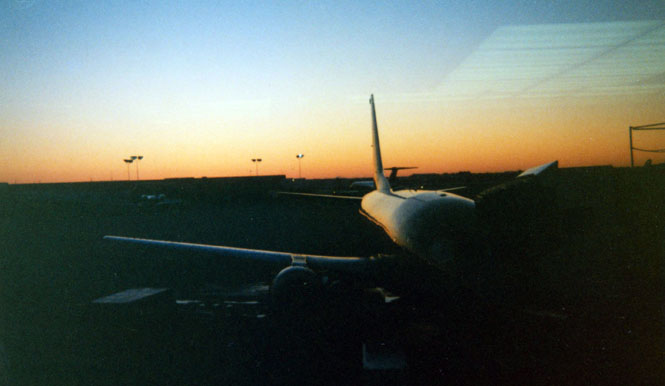
I was scheduled to leave Wichita Monday, March 9 at 2:40 PM. But, after arriving at the airport I was told that all flights through Chicago had been cancelled due to a severe snowstorm. So I drove back to work.
I was up the next morning at 5:00AM to catch my flight.
Now, you might think that the most direct way to London would be something along a northeasterly route. So it did seem a cruelty to have to first fly the opposite direction to Denver, Colorado.
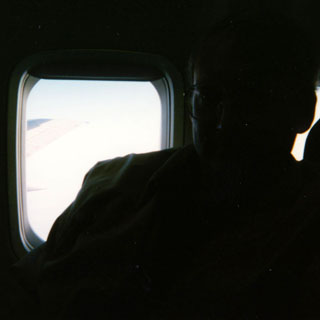

 Colorado
Colorado
This was my first experience with the new Denver Airport. I really liked it.
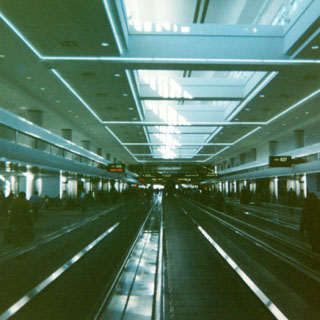

Terminals were very easy to find, there was nearly always a moving sidewalk available and the trains between terminals are smooth, quiet, and prompt.
I spent most all of the several hours in Denver walking through all areas of the airport (my connecting flight was delayed several hours). I even took the opportunity to walk one of their long moving sidewalks backwards.
This is a statue of Elrey P. Jeppesen, one of the all time greats of aviation, and for whom the terminal was named.
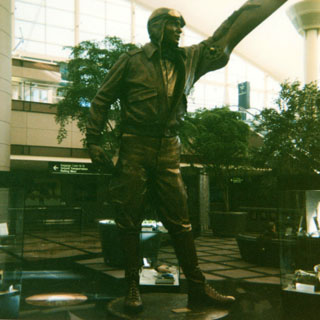
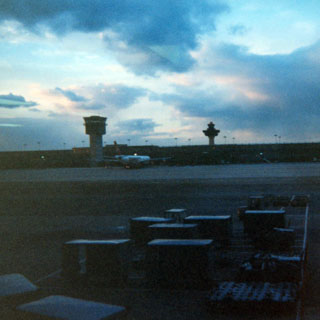
From Denver it was back across the country to Washington D.C. and Dulles Airport.
 District of Columbia
District of Columbia
The flight from Dulles to London (Boeing 777) was about as comfortable as trans-Atlantic economy can be.
 United Kingdom
United Kingdom
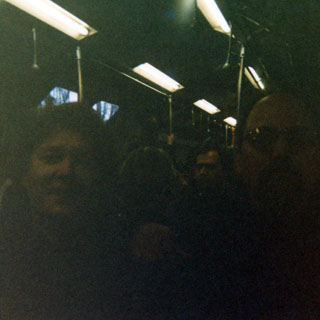 My introduction to England was
through Heathrow Airport. The
walk from the plane to immigration seemed to be miles, and none of the moving
sidewalks were working—or even seemed to have ever worked. Once in the immigration room (a
place with low, dark ceilings) I queued up with the rest of the silent passengers
in a long, snaking line before seeing the agent. Finally though, I met up with Becky and
Gil.
My introduction to England was
through Heathrow Airport. The
walk from the plane to immigration seemed to be miles, and none of the moving
sidewalks were working—or even seemed to have ever worked. Once in the immigration room (a
place with low, dark ceilings) I queued up with the rest of the silent passengers
in a long, snaking line before seeing the agent. Finally though, I met up with Becky and
Gil.
Joy! Let the trip begin!
This dark shot was taken while riding in the tube from Heathrow to Russell Square. I really liked the tube system. It has a well-worn, comfortable feel about it.
 England
England
After depositing my luggage at the hotel, we were off and running. As was usual, Gil and I were bouncing about with no direction known while Becky would consult her guidebooks and point us in the right direction. It looks rather damp in the picture, and it did drizzle a bit. But overall, the weather was just fine.
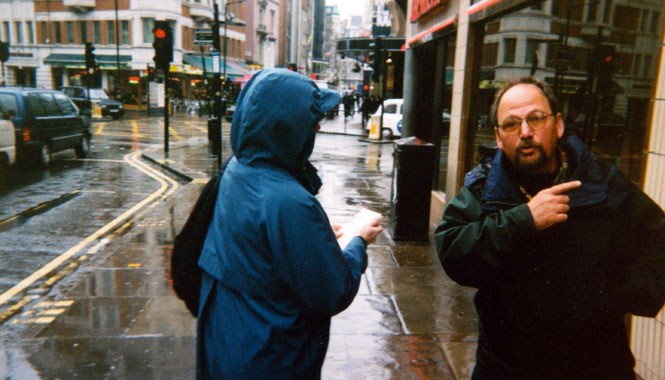
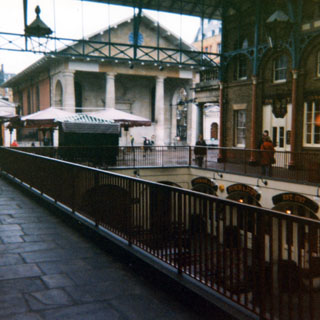
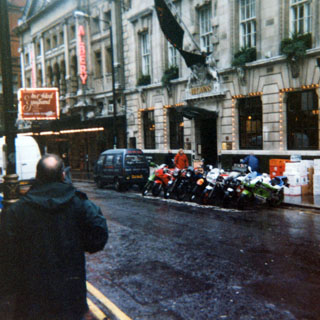
After a short tube ride, we emerged near Covent Garden Market.
Walking toward Trafalgar Square, down St Martins Street. It was along here that Becky (or was it Gil?) saw the actor who played somebody-or-rather on TV (The Enforcer, The Avenger, The Terminator, The Persuader--one of those...).
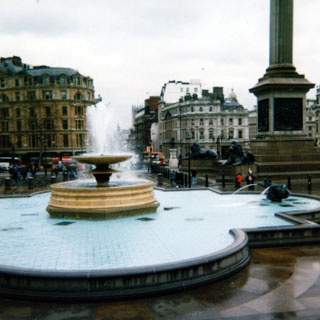
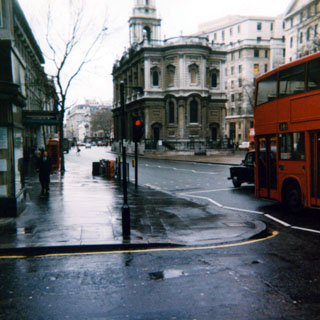
Trafalgar Square and Three Americans in London.
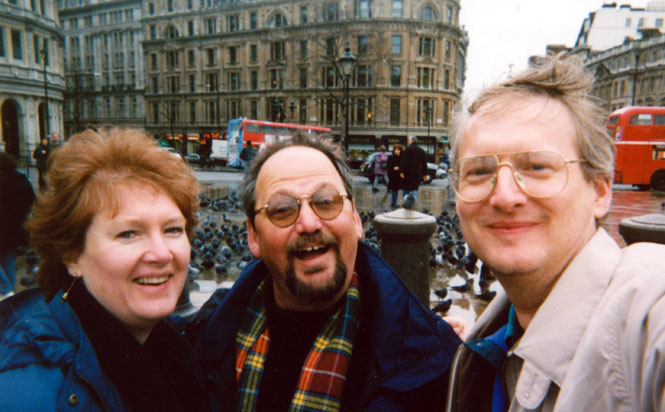
And here we have a memorial to Sir Arthur Sullivan. One can’t help but be a bit embarrassed for the old chap. But, Gil said that his was exactly the sort of memorial he wanted for himself (an inconsolable partially disrobed woman).


I bought a small amount of tea at Twinings.
We walked on down the Strand turning down some small alleys to the Temple Church. One of our people is buried there. The place is now (and has been for a very long time) controlled by lawyers through a system of church/legal/government that baffles me.

Part of the Temple Church. This place was originally the home of the Knights Templar until they were booted out for being too powerful. The main building was built in 1185(!) and somewhat demolished by German bombs in 1940.
We ate lunch in a sub-basement dinning room of the Pig and Cheddar (not the real name—but something along that line). That was my first meal in London, and I’ve got to say that almost nothing on the menu was familiar. The food was fine, though (and I’ve never seen a Coke bottle that small before).
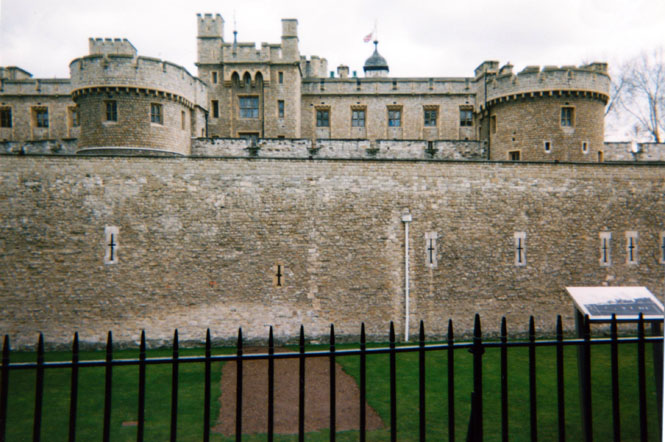
After quite a bit more walking we caught the bus to The Tower. Given the option before hand, I would willingly have skipped any attraction that I had heard of before—but this was worthwhile. In fact, I’ve rethought my thinking, and I’d now suggest that any visitor to London should just go ahead and do the full tourist thing if you’ve got the time.
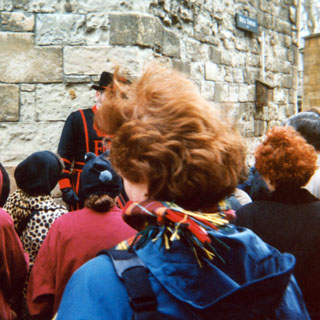
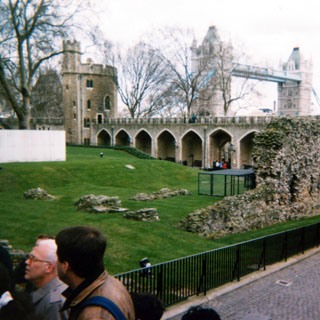
The guard/guides were really great. I can’t imagine how they maintain their enthusiasm through several tours day after day— especially when many of their charges would necessarily be French Children (We all loved English children--such a delight. But French children?).
Thatís the tower bridge in the background. That cage on the grass holds six ravens (held in captivity for reasons that are too wrapped in lore to be explained here).
After our guided tour of the Tower we spent more time going through a couple of museums on the grounds including the display of the crown jewels. Not to be missed.
Moving back up the Strand again. This shot was taken from the front of the bus (on the upper deck). Those red double-deckers are great. In fact their overall transport system is very impressive. You couldn’t go too wrong just riding one of the busses around its entire route.

We seem to have spent the remaining part of the day and on into the evening walking.
Walking, walking, walking. One of
the highlights, though, was dinner at the West
End Cafť (or something similar to that name). The place didn’t look too crowded at
first, but 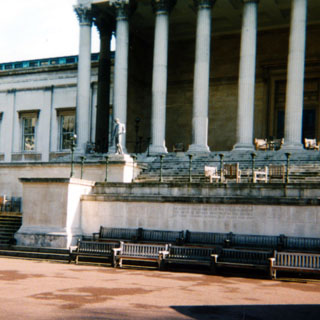 it turned out to be fairly full. We were directed into the lower level and
seated at a booth that was already occupied. Well, there’s room for three more
isn’t there? I had some sort of chicken thing that came with thoroughly
boiled carrots and peas. It
seemed somehow important that I eat all of it, so I did. Not recommended.
it turned out to be fairly full. We were directed into the lower level and
seated at a booth that was already occupied. Well, there’s room for three more
isn’t there? I had some sort of chicken thing that came with thoroughly
boiled carrots and peas. It
seemed somehow important that I eat all of it, so I did. Not recommended.
We boarded a bus the next day and set off for University College of London where we saw Mr. Jeremy Bentham sitting in his box (an eccentric sort; he asked for his body to be preserved for reasons that are not all together clear).
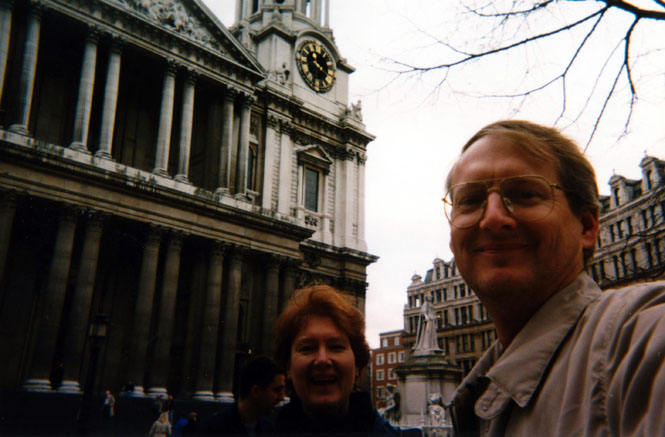
After more buses and more walking (and stopping at a fascinating umbrella store where Becky and Gil both bought very high quality umbrellas) we were back at St. Paul’s Cathedral.
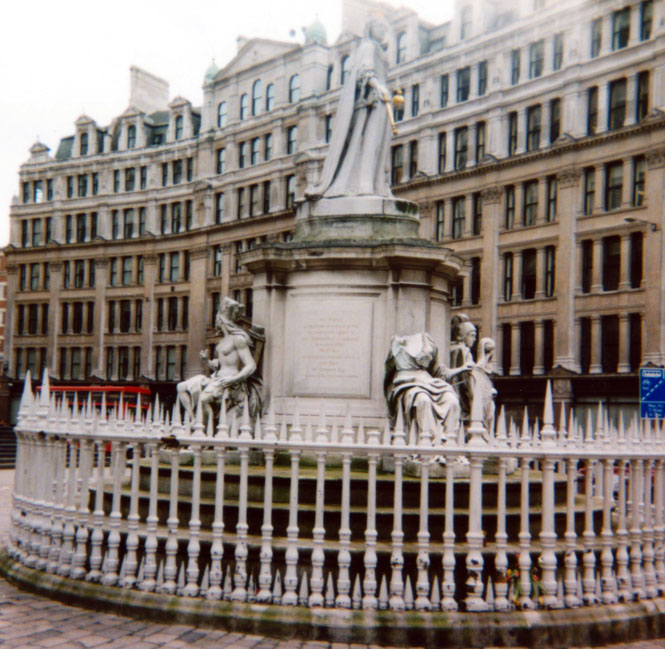
I gather that sitting on the steps of the statue is not now encouraged.
St Paul’s is a remarkable place. Although it certainly still serves its original purpose as a church, it comes across more as a monument to the greatness of England (properly, with Elgar playing in the background). Think of it as a combination of the U.S. tomb of the unknowns, capital rotunda, and Arlington National Cemetery all mixed into a single building.
As with most all cathedrals, the floor plan is in the form of a large cross with the rotunda at the center. Benches had been set up at the front, but the floor was otherwise clear. The periphery was covered with memorials and statues commemorating great events or people. The basement was open and was basically a large crypt with some enormous monuments. Admiral Nelson’s is probably the largest and most ornate. Unfortunately (I thought), there was also a cafeteria in the basement called the (sigh) Crypt Cafť.
 The truly remarkable thing, though, was that the stairs to the top of the rotunda were
open. The first hundred or so stairs are rather flat as they spiral up. At about the
halfway point you step back into the rotunda, except this time you’re on a wide ledge
(with railing) that runs clear around. Provides a very nice view of the people
below. The acoustics are such that a person who speaks into the wall can be heard 180
degrees away across the rotunda fairly easily. So while you’re resting on the stone
bench that lines the wall, you hear a constant "can you hear me?" "yes, can
you hear me?" from the other tourists. Great fun. For the serious walkers
(and that would be us) the stairs that continue up are now
quite narrow and much steeper. Eventually these give way to iron stairs that climb the
outside of the inner dome (but still inside the building) all the way up to the top. This
photo was taken at the mid level.
The truly remarkable thing, though, was that the stairs to the top of the rotunda were
open. The first hundred or so stairs are rather flat as they spiral up. At about the
halfway point you step back into the rotunda, except this time you’re on a wide ledge
(with railing) that runs clear around. Provides a very nice view of the people
below. The acoustics are such that a person who speaks into the wall can be heard 180
degrees away across the rotunda fairly easily. So while you’re resting on the stone
bench that lines the wall, you hear a constant "can you hear me?" "yes, can
you hear me?" from the other tourists. Great fun. For the serious walkers
(and that would be us) the stairs that continue up are now
quite narrow and much steeper. Eventually these give way to iron stairs that climb the
outside of the inner dome (but still inside the building) all the way up to the top. This
photo was taken at the mid level.
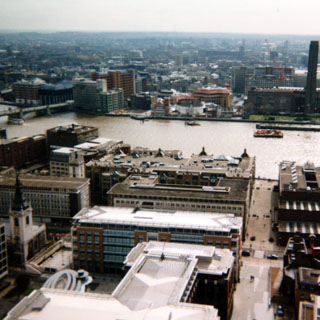
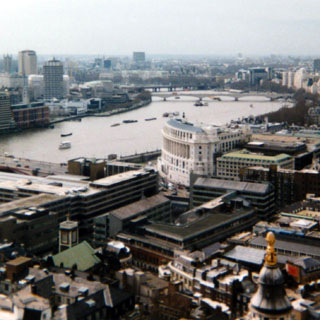
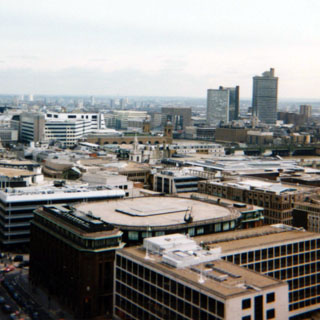
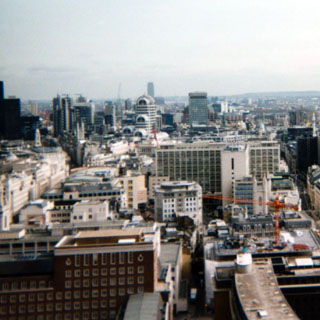
View of the Thames, taken from the highest point. In these photos you should be able to spot quite a few churches. Some really elaborate churches have been seemingly built within easy walking distance of each other. Just across the river is a reconstruction of Shakespeareís Globe (one of the places that we didnít go to).
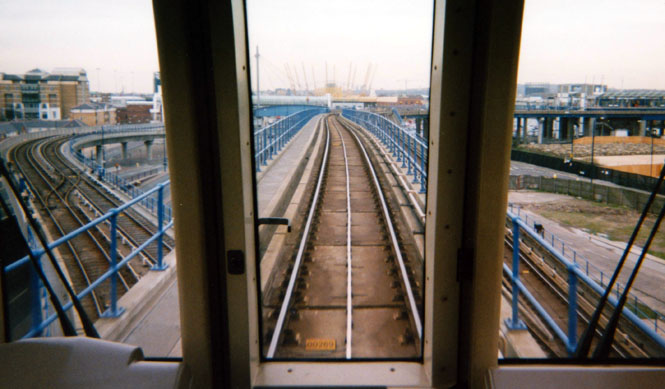
From St. Paul’s we caught another bus back to the Tower and then walked up to the rail platform to catch a "fast train" to Greenwich.

Actually, we caught the wrong train at first, but a kindly conductor gave as good guidance. To be accurate, the train stopped on the north side of the Thames, and we then walked under the river to Greenwich.
Were this any other place or trip, I would have spent time going over this ship (Cutty Sark). But as it was we took a few pictures and hustled on our way.


French children! A view of the Naval Museum (or words similar) taken from the observatory hill.

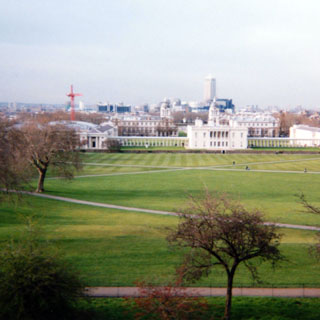
The prime meridian of
the world passes through this building. Longitude, zero. Off to the left in the photo you
can see part of a banner proclaiming some year 2000 event. Greenwich has great plans for
the year 2000. They’re erecting a huge domed building and are planning a huge
celebration. Trouble is—they aren’t really quite sure what they’re going to
do. They’re not even sure what they’re
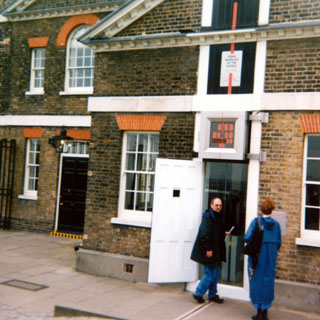 going to put in this huge building. And
proclamations to the contrary, the century won’t begin here anyway. It will begin
half a world away at the International Dateline.
(and let's not even talk about whether or not the century begins with 2000 or 2001).
going to put in this huge building. And
proclamations to the contrary, the century won’t begin here anyway. It will begin
half a world away at the International Dateline.
(and let's not even talk about whether or not the century begins with 2000 or 2001).
There was a nice exhibit on accurate time keeping including several priceless clocks that had been built expressly to solve the Longitude problem of navigation Somewhat marred by the incessant recording of a barking dog. It seems that someone had the bright theory that two dogs raised together (or were they from the same litter) would experience sympathetic pain. That is, if one of the dogs was injured, the other dog would whelp. So the idea was to send one dog on the sailing ship, and the port dog would be beaten at a given time. This would cause the ship dog to bark, and thus they would know the time.
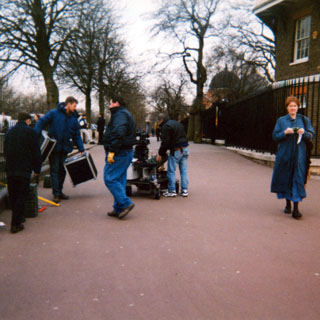 The camera crew here
was taking down their equipment after doing some commercial work (I guess). There had been
some talk that the crew didn’t want people taking their pictures, so naturally…
The camera crew here
was taking down their equipment after doing some commercial work (I guess). There had been
some talk that the crew didn’t want people taking their pictures, so naturally…
After more walking (walk, walk, walk) we caught a commuter train to Waterloo station, and then switched to another train that took us over the river and back into the City. We rather lucked out here. As was often the case, the signs were completely inadequate (for us). But we managed to find the right train out of dozens. We did try asking a train official which was the correct train, but it seems his entire job consisted of waving a white paddle for no obviously helpful reason.
We then walked back towards the river and down Whitehall to the House of Parliament. This was great fun. Since the light was shining on the clock tower (informing us that Parliament was in session).
First we were told to wait on some long benches in a grand entrance hall. After moving up to the next level for some more waiting, we were then told to march up several stairs to a security area. There we surrendered our cameras and the like and were patted down for weapons at least Gil and I were. We were then led into the upper balcony of the House of Commons. The House is not really a grandly large room, but it is full of historic touches (even though it is not especially old). The members sit on stadium benches facing each other with a large desk (and I mean really large) in the middle. At the head of the room sits the speaker who pretty much runs keeps things running according to the rules. The spectator benches run around three sides of the room, but we were limited to the benches at the foot of the room. The space between benches was so cramped that I found it impossible to sit facing straight ahead.
We watched for a good while and saw two debates. One was on whether elections should be moved from Sunday to Thursday, and the other concerned the fact that the opposition was being given full information on some bureaucratic issue. Unlikely, but I really enjoyed it.
After a recess was declared, we went to the other side of the building to watch the House of Lords. Unlike the security of the Commons side, the Lords didn’t really have any. Their room was vastly more impressive, with ancient woodcarvings of monarchs on the walls. They had a similar arrangement as the Commons except that we, the spectators, were now at the head of the room. And, instead of a large desk, they instead had a bed (what else could it be called?). And on the bed were several red bags of wool. The person doing the speaking sort of lounged on the bed leaning against the wool. Yes, I know that makes no sense. The discussion concerned some E.U. subject that I never could quite get hold of.
By now it was fairly late (these guys stay in session through most of the night) so at the next recess we caught a bus and made our way back to our Hotel.
The next morning we took a cab to the train station (Paddington) for our trip to Oxford. We had wanted a traditional English cab, but instead had an "Estate Wagon" (that would be station wagon to us). This one trip convinced me (as if it were needed) that I never want to drive in London. That is, if I wanted to get to my destination anyway. I have no reason to believe that he wasnít taking the most direct route, but we were on the most varied system of roads and alleys before we arrived at the station.
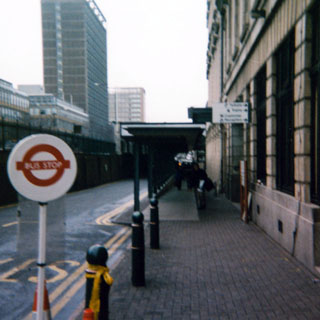
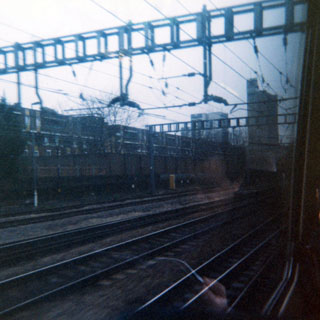
Our train was electric driven and seemed more of a series of busses than a train. Becky and Gil were at least entertained by a delightful English child.
 Elegance In a Class of Its
Own
Elegance In a Class of Its
Own
In a world of lookalikes, Leganza stands apart with poise and flowing elegance that
gets noticed. The styling is confident, almost regal, fully conveying the vigor and
agility of the advanced powertrain and suspension.
From the projection headlamps to the door lines, form follows function in every design
feature. For Daewoo, our first priority is safety. Each styling element must contribute to
keeping the driver and passengers out of harm's way.
The crowning touch is provided by the chromed radiator grille which imparts an
authoritative look and contributes to efficient engine cooling. Leganza brings a whole new
style to driving, a style you can proudly call your own.
It turned out to be a fine car.
We probably should have followed Becky’s original plan of picking up the car only on our way out of Oxford. As it was, we picked up the car immediately on reaching the city (the Avis shack is just across from the rail station). We then proceeded to drive aimlessly (it seems on reflection) looking for a B&B. We did finally find one that was within a short bus trip of downtown. However, the car remained parked across our street the whole time we were in Oxford.

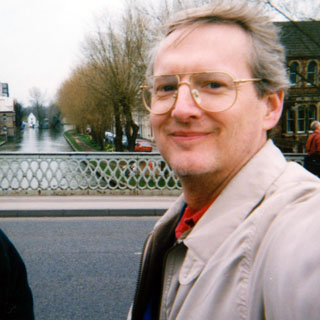
Oxford. I’m still not clear exactly on The Concept of the university. Oxford isn’t a single school. Instead it’s a conglomeration of many rather small universities all situated within a fairly small district in the city. Each university acts autonomously, but is still somehow connected to the whole. As such, they each wouldn’t have a school of biology, or medicine, or engineering, but instead concentrate on a more defined range of subjects. How that all works, I’m afraid I still don’t understand. In addition, the universities have a system of tutors that is not at all clear to me either. Each student is assigned a tutor who will stick with him throughout his college career. The role of a tutor is apparently much more than a mere advisor—more of an instructor really. In talking with (English educated) engineers who know the system, apparently tutors aren’t paid much at all. They’re on the lowest rung of a system that leads to lecturers, and on up through various levels of professors.


As must be true for any city of a given size in England, the bus system is wonderful.
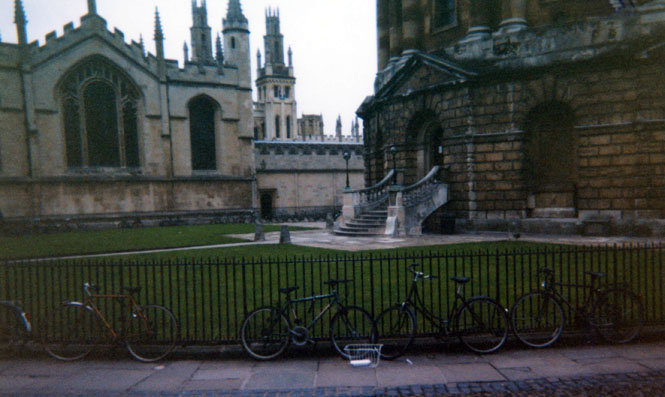
This was billed as the oldest free library in the world. We all took (private) issue with this claim, since we thought Benjamin Franklin had started the first public library. There is obviously some difference of opinion as to what "public" means (or what "free" means), since even today the "public" is not allowed in the library. Only a very select few (associated with the university) are allowed admittance.

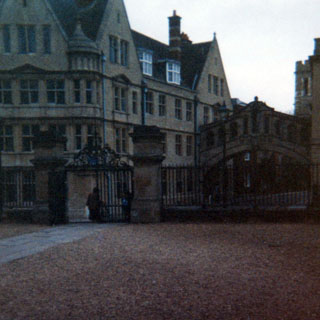
Wonderful buildings, all of them startlingly old.
It occurs to me that our guide (the next day) promised to tell a story of that bridge, but forgot.
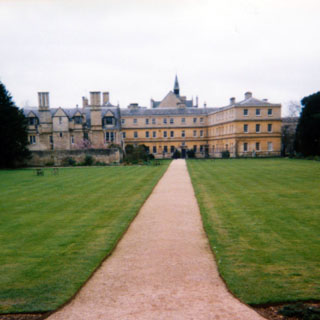

The next morning we took a walking tour of Oxford. We were led by the affable Marcel. He prefaced his explanations of the unusual items of Oxford by saying "now, don’t laugh." But, of course, we always did. His explanation of how Jesus College got it’s name was that when Queen Elizabeth was presented with the bill, her response was "Jesus!" I tell you now; "don’t laugh."
One of the universities. Many were side-by-side within the downtown core. This one looks more traditional (by our standards).

Becky and I climbed up more steps to the top of a very old bell tower. I could never get over the amazing stone construction of these buildings. The amount of work that must have been required to make them is just staggering. One of the still-standing bell towers in town dated from Saxon times. We’re talking over 1,000 years ago. Remarkable.
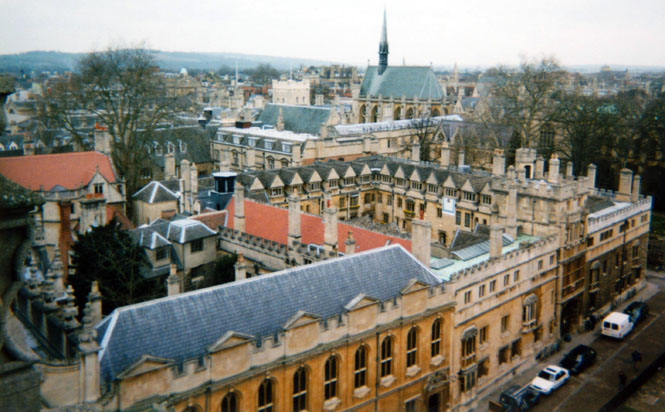
A view from the bell tower. I can’t tell you any of what you see there. But it’s likely that each courtyard and the buildings that surround it constitute a single university, so we’re looking at several in this picture.
So much to see, so little time to do it. The walking tour ended at the Natural History museum. One of the best in the world. So what did we do? We dashed through the first room on the first floor and called it good enough.
Our trip route out of Oxford was not very clean. After more diversions than I can recall we were finally on the A40 road only to realize that those "40" signs meant the speed limit and not the highway number.... Well luckily, we had a backup plan, so instead of fighting the current trying to find the right route, we stayed the course and took The A420 out of Oxford instead. We had planned to stop in at Blenheim Palace, but as it turned out, if we had done that, we would have arrived at our destination in Wales at dark and we would never have found our rooms.
Becky did the driving from Oxford to Wales, while I handled the return trip.
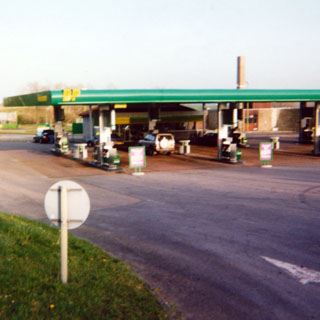

The towers of the Severn Bridge can be seen in the distance. If you look closely, you can see the toll booth in the center of the picture.
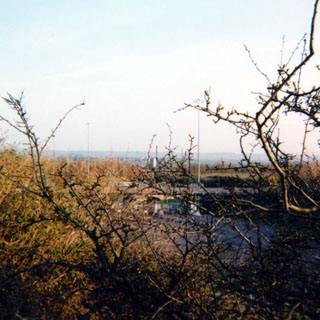

 Wales
Wales
The navigation over the Severn and into Wales went without much of a hitch. At Chepstoe we turned north and drove up the Wye Valley looking for the town of Llandogo (pronounced "Clandogo" except that you apparently need to say it as if you're hacking up phlegm).

We stopped initially at the Sloop Inn, and were then given instructions of how to get to where we really needed to be (just up the road a pace).
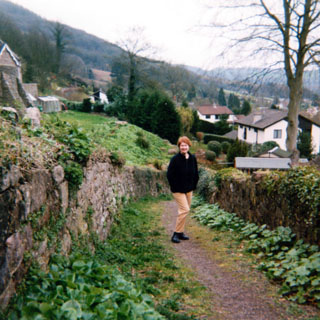

Ah, what a wonderful place. The Wye Valley is fairly narrow with moderate hills on either side. It’s very reminiscent of valleys I’ve seen in the coal mining districts of West Virginia. Which is appropriate, since coal is what this place used to be about. If one didn’t have to be practical, this would be a terrific place to just buy a house, and sit on the porch.
There is an extensive system of trails connecting the towns, and indeed, extending all over the countryside. I imagine that 100 years ago there would be draft ponies along these trails, but today it’s just people. Most of the trails were sunk into the ground like this. I wonder if that’s the result of hundreds of years of use.
We unanimously agreed that some sort of break in the action was need, and that we couldn’t think of a better place to do it. So this was to be a day of rest and semi-relaxation before forging on ahead.
Happy hikers.

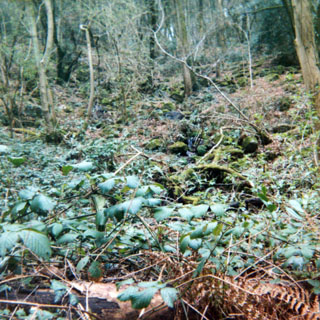
There was a series of stone steps dropping down into the trail. Some of the trails were quite steep.
Wales. We loved it.

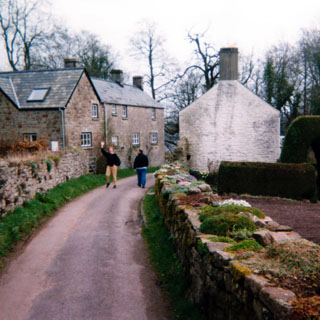
We hiked up the side of the hills and then continued along the roads.
A very small village at the top of the hill. Amazingly enough, after we walked for a while in a large loop, we somehow managed to return to this very spot again. Just try to figure out what happens if you’re driving down this road and a car comes from the opposite direction. Walking is good.

This creek flowed down the hill and into the Wye River.
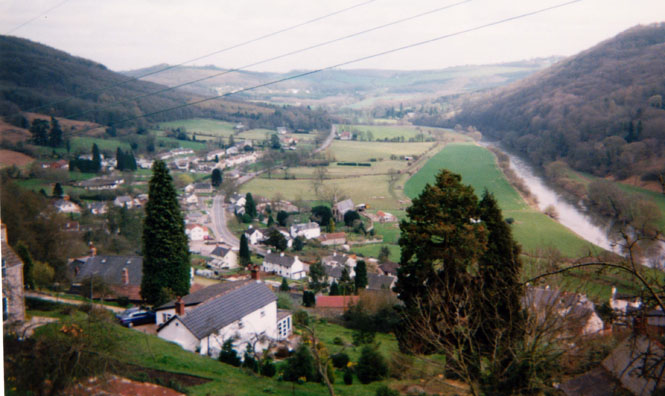
That’s Llondogo down there. Our place was on this side of the road towards the left side. The church in the center was just across the street from our drive.
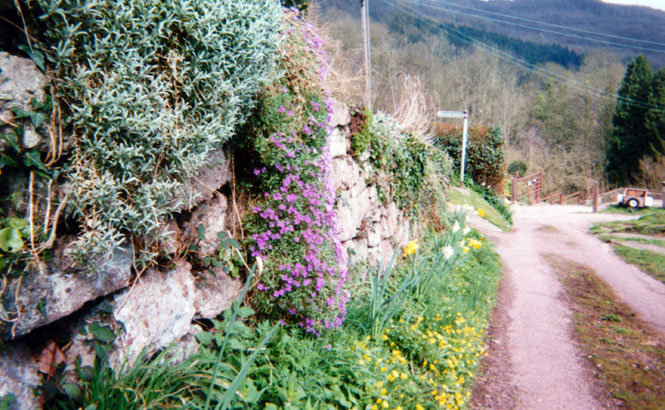
This is typical of the roads that the homeowners would have to drive up. In many cases, the road didn’t really seem to make it to the house. Obviously, people drive less and walk more than we do.
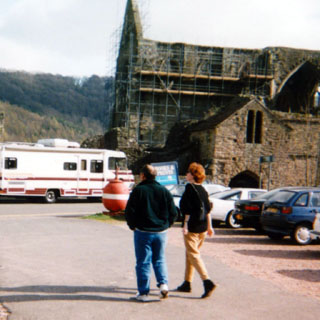 That afternoon we
drove down to Tintern Abbey. There’s something irresistible about an ancient abbey.
Some 500 years ago this was a fabulous structure at the entrance to the Wye Valley. And it
had been a going concern for many hundreds of years before that.
I wish that it hadn’t been necessary to have a parking lot and gift shop on the
grounds. It would have been much better if there were a 10 mile hike required to get to
the ruins.
That afternoon we
drove down to Tintern Abbey. There’s something irresistible about an ancient abbey.
Some 500 years ago this was a fabulous structure at the entrance to the Wye Valley. And it
had been a going concern for many hundreds of years before that.
I wish that it hadn’t been necessary to have a parking lot and gift shop on the
grounds. It would have been much better if there were a 10 mile hike required to get to
the ruins.
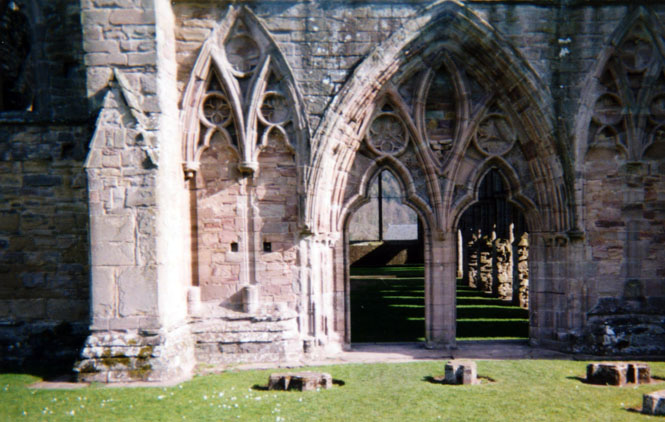
A fair amount of structural reinforcement had been done to the ruins to keep them from further deterioration.
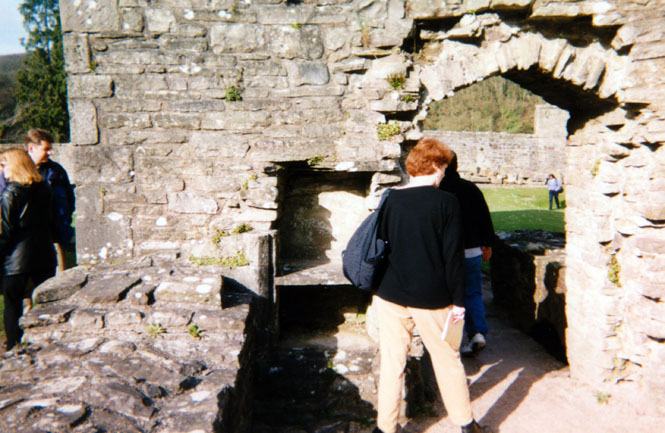
Next to the Abbey were several other buildings including dormitories and kitchens.
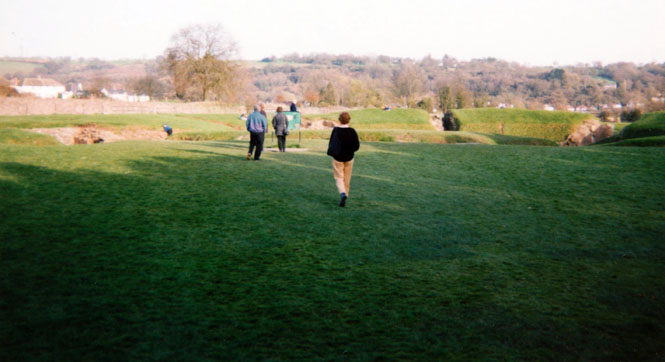
Further down the road at the ruins of a Roman amphitheater. That’s right Roman. And these guys were here for a few hundred years as well. This shot makes the amphitheater look like a golf course. The sunken floor is surrounded by mounded earth on which the stadium seats extended. There were several entrances to the stage that passed under brick arches.
 England
England
The next day we drove back down to Chepstoe to first make reservations at a B&B in Salisbury, and second to find an ATM to get some cash. It seems we hadn’t counted on paying cash money for the previous nights lodging, so we were a little dry. William the Conqueror wasted no time at all in erecting castles all over the south of England. We didn’t do much more than peek inside the castle.
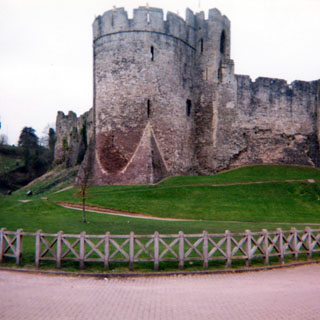
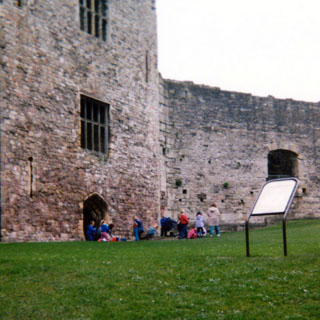
Those are pleasant English children. With the car parked in the castle parking lot, we walked past the castle and looped through the old part of the city. Judging by the number of closed up shops, and the thrift stores, this area is having some tough times. Still, when the buildings are 500 years old, it’s not possible to look "run down." Gil ducked into a bank to see if he could buy a Euro, the new European Community common currency. They didn’t seem too up on the issue, but it turns out that the coins aren’t available just yet (of course the UK does not use the Euro).
From Chepstow we shot across the M4 before turning south on the A4361.

Now we’re talking
really old. Forget that Roman stuff, forget Stonehenge; Avebury dates back at least 5,000
years. Hundreds of huge rough-hewn stones are erected in geometric patterns. Generally
there is a large ring with a very long avenue extending in a straight line. The avenue is
marked by a row of stones on both sides. Part of what interested me is the fact that they
aren’t arranged in a perfect circle, nor is the avenue exactly straight. Even with
very primitive tools, making a perfect circle and straight lines would have been simple,
so I figure these shapes were done intentionally. Well, your guess is as good as mine,
since no one really knows. This area was in use for some 3,000 years, which
 gives it a
continuity of purpose much longer than anything our own civilization might have.
gives it a
continuity of purpose much longer than anything our own civilization might have.
Our field general marched us down a public path, up the road, and onward to a long barrow (tomb).
The large stones mark
the entrance to the barrow, a part of which was open to us. The bulk of it had been filled
in, and in fact much of it has never been excavated. People have been buried here over a
span of 2,000 years or so. These people, with such a steady, unchanging civilization from
one generation to the next, must have had an entirely
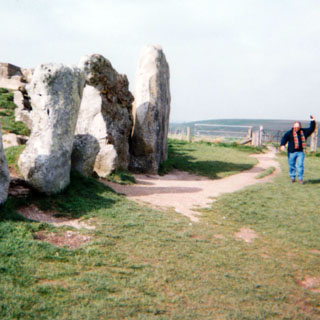 different attitude towards time than we do.
We tend to consider events that happened 500 years ago as historic, and from a
different "time." We may know some of the events of that time, but we really
canít appreciate fully what it was like to live then. But what if the people 500
years ago, or even 3,000 years ago lived exactly like you, and followed the same
customs and held the same beliefs? The concept of "progress" would have no
meaning at all, and there would be no uncertainty about the future.
different attitude towards time than we do.
We tend to consider events that happened 500 years ago as historic, and from a
different "time." We may know some of the events of that time, but we really
canít appreciate fully what it was like to live then. But what if the people 500
years ago, or even 3,000 years ago lived exactly like you, and followed the same
customs and held the same beliefs? The concept of "progress" would have no
meaning at all, and there would be no uncertainty about the future.

Salisbury hill is the largest man-made mound in Europe. It is made entirely of chalk and took perhaps 100 years to make. Our own hike would take us around that low hill on the right side of the photograph back to Avebury. The hill is 130 feet high. The similar Cahokia Mound in Illinois is just 100 feet high, so it looks like our own natives were bested by the Brits. And ours is just dirt--not chalk.
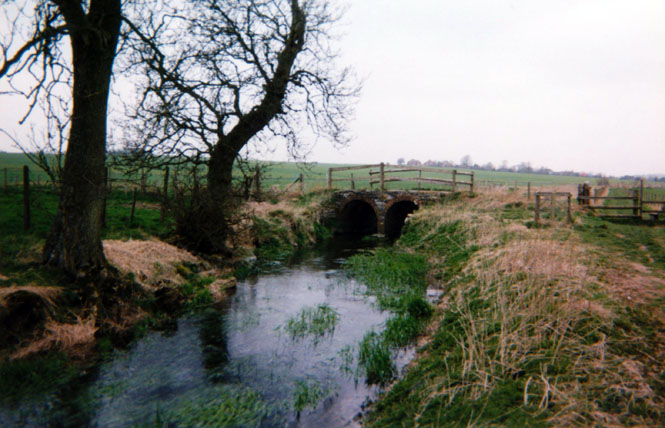
Our path follows the ditch on the right. You can just see the bench needed to step over the fence.
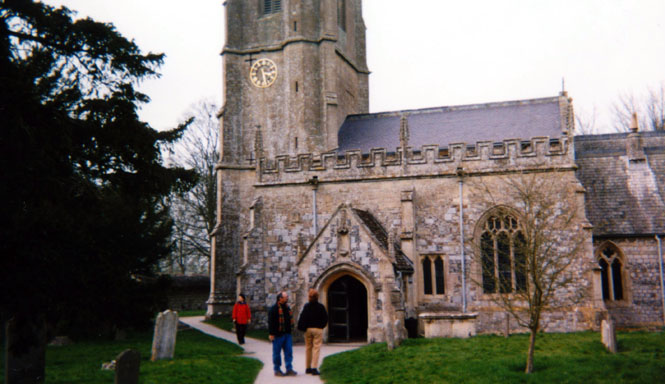
Back in Avebury now. The village is located just about in the center of the Stones. The first reaction is to be irritated with these interlopers, but then realize that the church is Saxon and is over 1,000 years old so I suppose they shouldn’t have to remove it.
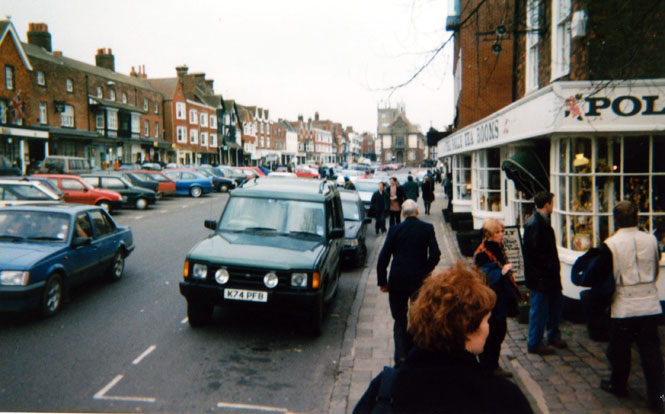
It was getting on towards late afternoon, so we stopped in Marlborough for lunch. This was a busy touristy sort of place. The main drag (seen in the photo) was two miles or so long with shops and restaurants on either side. Parking was down the center of the street and along the sides which, when combined with all the pedestrians, seemed an accident in the making. We had a wide choice of restaurants and pubs to choose from. But, somehow we ended up at Polly’s. A tea house. Oh, and before I forget, the photo was shot with my arm extended straight up (I haven’t gained two feet in height over Becky). Anyway, back to Polly’s—apart from tea, there wasn’t much in the way of real food. But there were plenty of doilies.
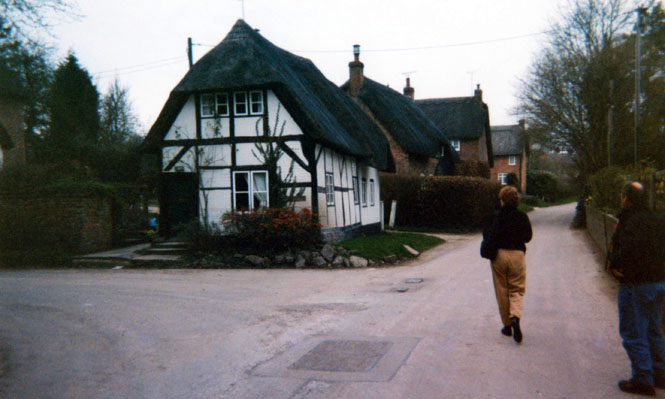
Back in Chepstow the tourist center recommended that we stop in Wootton Rivers. It’s your prototypical quaint English village. And, it was nice.

Apart from the village, I’ll remember the roads into and out of the town. Single-lane sunken roads. You know that there’s farm land on either side of you, it’s just that you can’t see it.
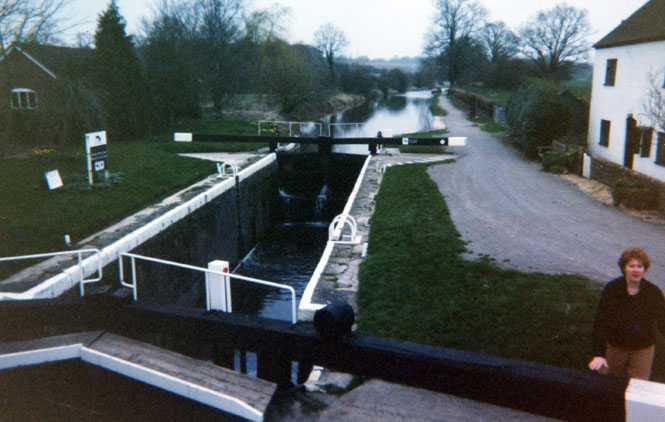
We passed over the Avon canal leaving Wootton Rivers. There’s not too much river traffic anymore, but it’s nice that they maintain them. The locks are controlled manually.

I began to get more comfortable with the narrow roads as we drove on into Salisbury (across the Salisbury Plain). Give me a few more days and I think I could be dragging the hedges on the side of the car with the best of them. This shot of our B&B was taken the next morning as we arrived late in the day. A rather so-so place. No shower.
That evening we packed a bag of dirty clothes and made our way into the city center. Seemed an odd thing (reflecting), walking through a dark park somewhere in England carrying a bag of dirty clothes. Afterwards (now with a bag of clean clothes) we walked to a pub for ale and then across the square to a pizza place.
Salisbury Cathedral. Built around 1220. Highest spire in England (404 feet). Amazing. Time was just running out on Gil’s shilling in the telescope when I stuck the camera in the eye-piece. It looks like we’re focused just above one of the windows in the tower.

We went on a tour of the tower led by a volunteer who turned out to be active in bell ringing. He later invited us to come down to a near-by (even older) church to watch their group’s practice session. The cathedral is also the home of several important documents including one of the original copies of the Magna Carta.
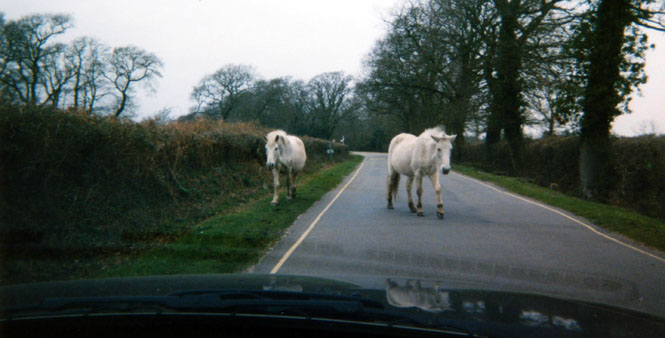
 After shooting the
round-abouts we headed south towards Bournemouth and then New Milton. New Milton is the
home of the Sammy Miller motorcycle museum.
After shooting the
round-abouts we headed south towards Bournemouth and then New Milton. New Milton is the
home of the Sammy Miller motorcycle museum.
Miller was a factory Grand Prix rider for NSU, but is mostly known for being a multi-time trials champion through the 50’s and into the 70’s. He’s retired now, but is still active in vintage events Sammy is the equivalent of our own Dick Mann (a statement that may not mean much).
From New Milton we made our way (somehow) over to
Beaulieu and the National Motor Museum. Unfortunately, it was getting late
(we
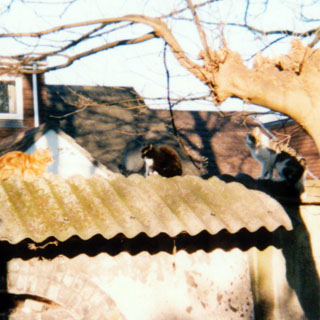 needed to get back to Salisbury for the bell ringing), so we passed on going
through. Next time.
needed to get back to Salisbury for the bell ringing), so we passed on going
through. Next time.
Two cats on a fence.
The roads around New Milton and Beaulieu took us through the New Forest. I naively thought "new" might refer to some fairly new replanting effort from (say) 1950 (as with the "new forest" in Nebraska). No. The name dates back to 1200. For some archaic reasons, the area is infested with small, stubborn ponies. They’ve been here for centuries and can’t be harmed, so they think nothing of walking slowly down a road, or even just stopping for a rest. Even cows know enough not to stop on roads.

Back in Salisbury, Becky made arrangements at a much better B&B. This was a professionally run place with an owner who is well on the way to full eccentric. I talked with him in the morning, before Becky and Gil arrived, about how our system of government works, specifically the budget process (which wouldn't seem to be very interesting). After the others arrived, we talked about everything from how to cook a tomato to the gross tonnage of trucks. I can't imagine how he manages to cook breakfast when he has a larger group than just us waiting.
That evening we walked the short distance to the old church to watch the bell ringers. It’s a fascinating thing, and almost exclusively English. The general concept is this:
You’ve got a certain number of bells—each one with its own tone. The object is to ring each bell in turn (in a defined series) until each bell has rung once. Then the pattern is changed slightly and the bells are rung again. This is repeated until all possible patterns have been rung.
Well, it doesn’t take much thinking to realize that the total number of patterns for a given set of bells is n!—or for 8 bells there are 8*7*6*5*4*3*2= 40,320 possible combinations. In practice, this number is greatly reduced since the tenor bell (largest) is (almost) always rung last each series to help everybody keep track of things. Also, owing to the large inertia of a swinging bell, it’s impossible to change the order of things more than just one position at a time. That is, if the first cycle is 1-2-3-4, the next cycle could be 1-3-2-4 with bells 3 and 2 switching spots. So the trick is to remember which of the other bells you are switching with, and in what order. These things are full of patterns, so it’s certainly not beyond the impossible to memorize. Becky and I both had a chance to swing a bell. Afterwards, Dennis and Barbara Martin invited us back to their home for coffee.
Taken the next morning. This is the bell-ringing church.
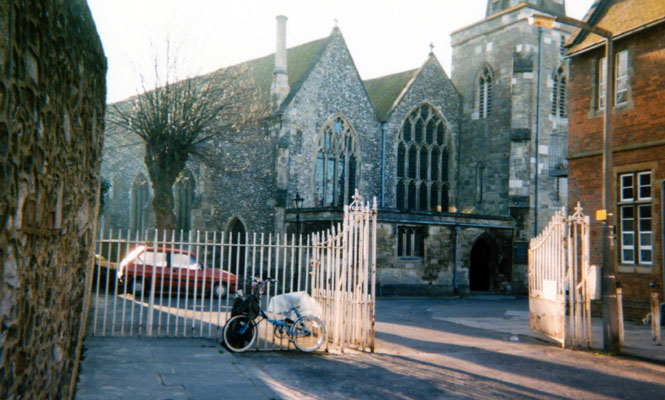

After whipping through the Salisbury roundabouts one last time, we were off to Portsmouth. The HMS Warrior is built in 1860 and at one time was the largest, fastest, armored, warship in the world. It was the first all-iron, steam powered ship.

HMS Victory. Built in 1759, and in service through the end of the 1800’s. A remarkably long period for any ship let alone a war ship. This was Lord Nelson’s flagship in the battle of Trafalgar, and was where he was killed during that battle.

This thing is in very good shape. We took a tour of the ship that extended several decks down, and let us see quite a bit of the ship. It would not have been pleasant to serve aboard her, but as was pointed out several times, itís unfair to make judgments on the conditions of those times against the standards of today.
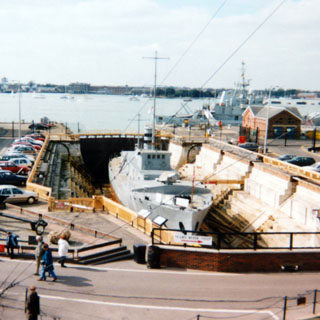
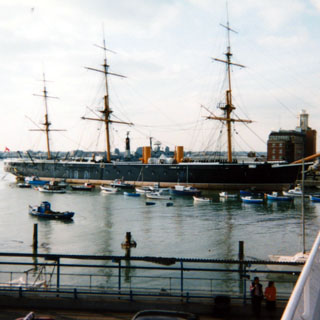
From Portsmouth you can catch ferries to several locations in France as well as to the Isle of Wight (not far away).
I didn’t take any pictures of it, but we also toured the Mary Rose, which was Henry VIII’s flagship. It is currently undergoing preservation after having spent many years on the bottom of the harbor (or the Solent) after sinking in 1545. We also toured the naval history museum. Unfortunately, information overload set in about this time, so I wasn’t giving the proper attention to some truly historic artifacts.
Whether to see a little of a lot, or a lot of a little was a constant theme throughout the trip. I think, in the end though, that we struck a good balance.
After our travel agent (that would be Becky) made arrangements at a hotel in London near Heathrow we left Portsmouth and blasted up the A31. I thought that by simply following the signs to London that we’d be on the (more major) M3, but it really didn’t matter. Funny thing though, we’d be cruising along on a six-lane freeway, when suddenly the lanes would disappear and we’d be on a narrow two-lane road. Then just as quickly, we’d be back on a freeway.
At Heathrow, we turned our car back in, and caught a shuttle bus to the subway station.
I suppose this would be called a "working class" neighborhood. But at least we had showers. Taken early the next morning as we were walking (longer than expected) back to the subway station. This is just a typical side street.
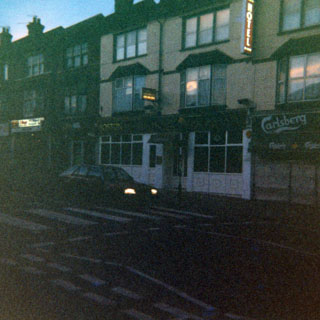


Once we were back in the airport and checked through customs and immigration, Becky and Gil vanished. Their flight was reported ready for boarding. I hung around a bit longer before boarding another Boeing 777 for the trip to O'Hare, Chicago.
 Illinois
Illinois
This shot was taken from the train that brought me to the Domestic terminal.

This trip started with a delayed flight out of Wichita due to snow in Chicago. Now I was delayed in Chicago due to snow in Wichita. I hung around this airport some 7 hours waiting for things to clear.
Interior of O'Hare.

Excellent trip.